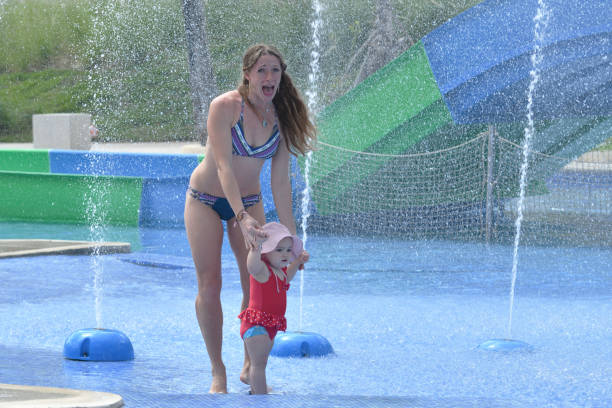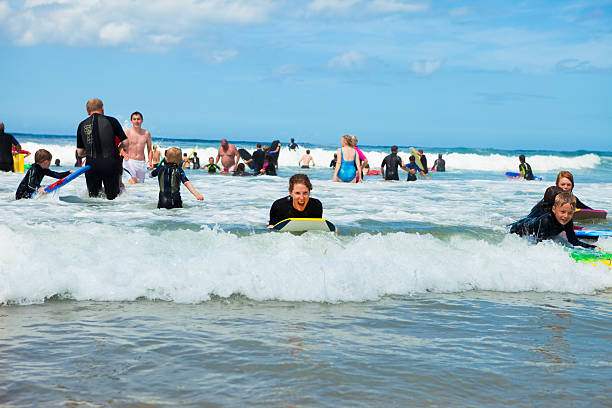How to Get In
Today I will talk to you about safely getting your baby into the water. It would help never to carry a child downstairs or ladders into the water. This is because if you fall, you will take your child with you. We do not recommend this. We recommend a mat that you can wet. You first wet the mat in water and then place it next to the water surface on the pool side. Then, you can kneel and place your baby on the changing mat. It will be nice and warm. This will stop them from stepping straight on to the cold concrete of the pool’s side.
As you lay your baby on the mat, make sure that his feet point towards the water and his head is facing the opposite direction. Then you can sit next to your baby. Put your arm over the baby. This is your safety hand. This will stop your baby from rolling to either side, and make sure they are safe before they enter the water.
As you slide in the water, turn as you go. As soon as you are in the water, place both your hands behind the baby’s neck and head to ensure it is fully supported. You can safely bring your baby into the water by gently leaning them towards you. Bringing your baby in the water this way is much safer than carrying them down the stairs.
You can get help from someone else if you’re going swimming together. They can put their arms around the baby and place it on the changing mat. We don’t suggest that the other person pass the baby across the air to you, or even in the water. It’s also because, if the person drops or slips and drops the baby, it is a very long distance for them to fall. Putting the baby on the mat before bringing them in the water is safer.
Swings & Dips
Swings and Dips encourages your child to spend some time flat on his back in the water.
You first swing your baby in a seated posture, supporting the head and neck. Then, gently rock it flat on the surface. You can keep your baby flat on the surface of the water for as long as you like, and then gently lift them back up. If your baby doesn’t like being on its back flat on the water, you can gently rock him flat for a few seconds, and then get him back up.
It’s a great way to bond with your baby. Let them have their ears submerged in water to get used to the pressure and how it feels. This is a fun activity that will help you bond with your child. So smile and make eye contact. Make it as much fun as you can.
Breathing
We will talk about breathing exercises and why it is important to start teaching breathing from an early age.
We introduce these activities as early as possible to help your baby learn to breathe above and below the water when swimming. This is a natural way to swim. Two hands are placed behind the baby’s neck and head to support their head. Then, you bring your child in toward you and sit them up. Inhale above the water and gently blow bubbles in the water. You baby may not be copying your actions yet, but he or she will learn from you and then want to copy you when they are older.
You can also practice bubbles if your baby has good neck and head control. This is done by holding their tummy with one hand, a nice relaxed position. Inhale above the water, and exhale under the water. It’s fun, and your baby will soon start to mimic you.
Kicking
Let’s explain how to help your baby learn to kick his legs in the water. You must always support their neck and head. Bring their head a bit closer to your chest. If not, you can keep them on your shoulder to ensure that their mouths are clear of water. Depending on how you support their head and neck, you can help them kick their feet with your hands or hand. They will learn to kick their legs in the water.
While you are practicing kicking your legs, you can play games or sing songs to keep the kids entertained. It builds up their muscles through their legs as well as their spine. You can use your hands to assist them in kicking their legs while they are in the water. These activities will help them to learn how push themselves forward in the water and strengthen their muscles.
Splashing hands
Splashing your hands in the water while swimming with your child is a fun thing to do. Splashing your hands in the water is a lot of fun. It gets water splashed on your baby’s faces. If they learn this from an early age, they will understand that it is normal. And if you take them swimming, then they are going to get water splashed in their faces.
You can start by helping them. Support them with your arm, positioned across their chest and tummy. Use your other hand to help them splash water on their hands. You can do it yourself if they don’t want to splash their hands. You can splash next to them to give them a taste of it. Later, when they are older, or perhaps a little bit older, they may want to do the same.
This is a fun, exciting activity. Arm movements in the water lead to paddling, and then swimming on your back, pulling water behind you.
Walk-Floating
This walk-floating is done with your baby lying on its stomach. This is for babies who are more wriggly, and don’t like to be on their stomach anymore.
Your thumbs should be in the “V” shape to begin with. Your hands will support the baby’s head and neck and, if they start to chin drop, you can support them. Your baby will still be facing forwards, and the head of your child will go first. This is a great opportunity to bond with your child and make eye contact. Smiley faces will encourage your baby to relax in the water.
You can move them gently side to side so they get used to the water flowing across their bodies. You can move to a more relaxed hold if your child is still relaxed and has good neck and head control. You tuck your fingers under the shoulders of your child and place your hands flat on their stomach. Position your hands pointing slightly upwards to encourage the chin and mouth of your baby to be above water. This position allows your baby to move freely in the water. You are still moving forward and you are still moving backwards. You can also gently sway your baby from side to side if you want them to feel the water more.
You’ll learn how to walk-float on your baby’s back. It’s important to support the baby’s neck and head, and also to support under their seat. It’s important to not put too much pressure on the baby’s back.
We practice walk-floating with the baby on their back to encourage water to move across their body, and get them used to how it feels to move in water. You can release the hand from underneath your child’s seat when you start moving and they have a little momentum. This allows them to be more independent and more free in the water.
You can keep your hand under their neck and head while you are moving backwards. The water supports the body, the seat and the legs. The muscles in the legs of most people are denser than their fat in the arms and tummy. It’s okay to keep your hand under their neck and head while you move. If you decide to stop moving, then you need to put the hand back under their seat. You can sink their legs in the water if you don’t. It also puts strain on their neck.
Cheek Support
When your baby starts to move more, or if you want to give them more independence but they are still happy lying on their backs, we use what is called a “cheek support”, which is two fingers either side of the cheek. This is okay as long as you keep moving. If you stop, then you will need to support the seat underneath again.
As long as we can, we keep our babies on their backs. It’s good for the alignment of the baby when swimming. When a child is lying on its back, it’s easier to teach them a flat and natural swimming alignment than if they are on their stomach.
Get Out
Now we’re going through the safe way to exit from the water when you are swimming with your child.
We recommend using a change of clothes mat, get it wet to make it warm and then lay it flat beside the pool. You can also use a change mat if you are swimming alone and the freeboard is low. The free board will be the edge the water compared to the edge the pool. If there is not much of a difference, you can place your baby with their feet facing the water on the mat. Then, you place one arm around your child and climb onto the side of your pool. We recommend you always keep your arm on your baby because it will stop them from rolling into the pool if that happens. We can place the mat as near to the steps as we can if the free board is high or there are steps integrated into the water, like at this pool. You lay your baby down on the mat the same as before. Make sure their feet point towards the water.
Then, you can start walking out the steps while keeping your arms on either side. When you are sure it is safe, you can then climb up on the side of your pool and hold your baby.
You can also get your baby out of the pool by laying it on the warm mat. The other person will gently place their baby on the warm mat with their feet again pointing toward the water. You can hold your baby in either arm while the other person lifts the baby up and out of the mat as usual.





